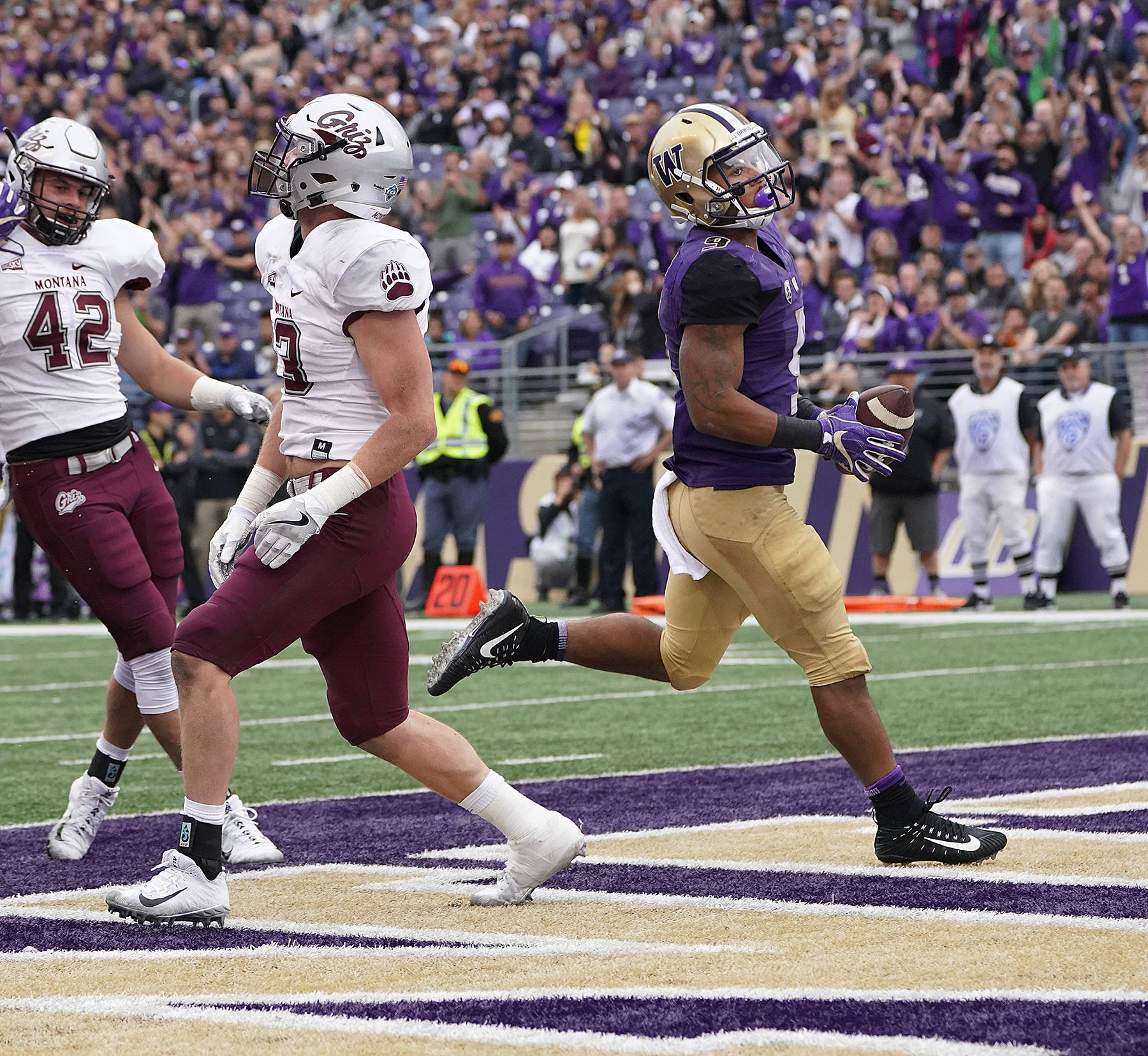By Percy Allen
The Seattle Times
Whenever anyone nears the Washington Huskies all-time rushing record he once held nearly four decades ago, Joe Steele is invariably asked: Who is the best running back in school history?
“You get these records and people always poke at me every once in awhile when somebody breaks them,” Steele said. “It’s great because it means the program is having success.
“But then there’s the debate. People are always trying to compare eras in football, which is so hard. But it’s fun too.”
The former UW great was pulled into the “Whose the greatest?” argument in 1979 when he finished with 3,168 yards and shattered the school record that the legendary Hugh McElhenny established in 1951 and held for 28 years.
Since then, Steele has watched Napoleon Kaufman, Chris Polk and Bishop Sankey gallop past him to the top of UW’s rushing list.
And now here comes Myles Gaskin.
When No. 6 Washington (5-0, 2-0 Pac-12) plays California (3-2, 0-2) tonight, the 5-foot-10, 191-pound junior needs just 26 yards to pass Steele and move into fourth place on school’s career rushing chart.
“I like him,” Steele said. “He sure packs a punch. He’s crafty. He’s got great patience and great vision. For his size I think he’s extremely powerful, and he’s got pretty good jets. He’s got great speed. It’s pretty impressive what he’s done.”
Gaskin has been remarkably consistent since a breakout Week 2 performance as a freshman when he ran for 146 yards on 14 carries.
He finished the 2015 season with 1,302 yards and averaged 5.7 yards per carry. In 2016, Gaskin tallied 1,373 yards and averaged 5.8 yards per attempt.
At first glance, it appeared as if UW’s nonconference opponents were able to contain Gaskin in the first three games, considering he didn’t have more than 59 yards in any contest.
Actually, Gaskin averaged 6.4 yards per carry and didn’t receive many attempts in the second halves of the early blowout victories.
“When his number has been called, he’s been pretty productive,” offensive coordinator Jonathan Smith said. “We have other backs so Myles doesn’t have to carry the full load all the time, especially in games when we can get a big lead late.
“You want to keep him as fresh as you can because there’s going to be times when we really lean on him.”
During a 37-10 win at Colorado in the Pac-12 opener, Gaskin carried 27 times for a career-high 202 yards and two touchdowns.
And last Saturday, Gaskin pounded Oregon State for 113 yards on 15 carries. In each of the past two games, he’s averaged 7.5 yards per attempt.
“I’m more mature in the sense of knowing plays and not letting things get the best of me,” Gaskin said. “I’m not letting the moment get too big and get too excited. I’m able to tone it down and talk to myself.
“Now that I’m older, in those moments I take a breath, relax a little and then here we go. Then also always trying to help out the younger guys. It’s always good to be able to teach somebody something new, and it helps you learn even better.”
With 468 rushing yards, Gaskin ranks fifth in the Pac-12 during a season in which running backs in the conference and across the country have dominated college football highlights.
Stanford’s Bryce Love, who leads the nation with 1,088 yards, is on pace to break Barry Sanders FBS season rushing record (2,628), and Penn State’s Saquon Barkley is arguably the leading Heisman Trophy contender.
“All of those guys are doing great and I’m trying to pick up little things that you see on them playing and see how they play other teams,” Gaskin said. “It’s just cool to see other guys do well. As a running back you sometimes get left behind. You kind of get in the pass blocking and all of that other stuff.”
Gaskin has developed a reputation as a patient and explosive runner, but his biggest improvement this season has been in pass protection and as a receiver.
“This is the first year I’ve really been catching the ball since elementary school,” said Gaskin, who has eight receptions for 98 yards. “And as blocker, my technique is so much better. Sometimes you whiff when you’re throwing your body in there, and I was doing that a lot. But when you keep your feet going and use your hands and know leverage …
“It’s just getting older. I’m better today than I was yesterday. And hopefully, I’ll be better tomorrow.”
At his current pace — Gaskin is averaging 93.6 yards per game — he would finish the regular season with 1,230 and land in third place on UW’s all-time list at 3,798 behind Kaufman (4,106) and Polk (4,049).
“If he stuck around here for four years, he could be pushing up some serious yardage,” said Steele, who acknowledged few standout running backs return for their senior season. “It’s tough. If these kids are ready to go, they kind of have to go.
“But we’ll see. It depends on what his interest are and the education part of it. They’re both physical games, but the NFL is such a physical game.”
Whether Gaskin leaves early for the NFL is a question for another day.
For now, Steele is struggling to find an answer to who is the best running back in UW history.
“The old-timers are going to piggyback on McElhenny, who many of us never saw play,” said the 59-year-old Steele. “Napoleon Kaufman was pretty special in a special era. It’s really difficult to pick one, but he was pretty special and fun to watch. The teams he played on had a lot of success and winning that national championship.
“I love them all. I really do. And (Gaskin) belongs in that conversation.”


